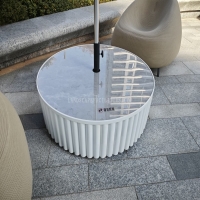Welcome to the website for landscape facilities products and knowledge.
What are the key design considerations for landscape tables in historic or culturally significant areas?
Designing landscape tables for historic or culturally significant areas requires a delicate balance between functionality, aesthetics, and preservation. The primary consideration is respecting the site's heritage. Tables should complement the existing architecture and natural surroundings, using materials and colors that blend seamlessly. For instance, reclaimed wood or stone can echo the area's historical character while ensuring durability.
Another critical factor is scale and proportion. Oversized or modern designs can disrupt the visual harmony of a historic site. Instead, opt for modest, timeless designs that reflect the era or cultural context of the location. Accessibility is also vital; tables should be inclusive without compromising the site's integrity.
Sustainability plays a key role. Eco-friendly materials and low-impact installation methods help preserve the area for future generations. Lastly, consult local historians or cultural experts to ensure the design aligns with the site's significance. By prioritizing these elements, landscape tables can enhance visitor experience while honoring the past.
Related search:

Recommendation
Round metal tube border design table with tempered glass or granite countertop on the top.